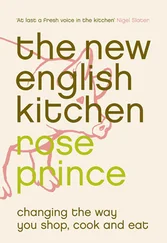With the exception of the glutamate family (E621–633), flavourings do not need ‘E’ approval. With natural flavouring, this is fine but flavourings fall into three interesting categories:
• Artificial– chemical imitations of real flavours.
• Nature identical– nice euphemism, where the actual chemicals present in real flavours are extracted to make flavourings.
• Natural– real essences and dried flavours.
When shopping, bear the following in mind as you read labels: if a manufacturer has added flavourings and colourings, the other ingredients are substandard. Avoid such foods if you can.
Read the labels of everything you buy. They tell you nothing and they tell you a lot. When they say little, that says a great deal; missing information is an indication of poor production standards or dubious origins. Ingredients must be listed on labels by law, in descending order of quantity, and most labels also include nutritional information – the place to spot the presence of salt, saturated fat, sugar and sometimes hydrogenated fat.
Logos say something about the food. Watch for the five British organic logos (the Soil Association one is the best known). The Demeter logo indicates biodynamic food – delightful stuff that has been grown in accordance with lunar cycles but which is basically organic. The red Lion Quality mark stamped on eggs means they came from hens that have been vaccinated against salmonella. The Fairtrade logo tells you the producer received a fair price, and the fishy-patterned Marine Stewardship Council (MSC) mark is a sign of fish from a certified sustainable source.
Other logos are more ambiguous in what they say about the food in the pack. The Red Tractor covers a wide range of production assurance but allows for intensive production. The same can be said for ‘Farm Assured’ and the British Quality marks for beef, pork and lamb. LEAF allows pesticide use (though under stricter controls, but I have visited LEAF farms and been impressed with successful schemes boosting wildlife). The RSPCA’s Freedom Food logo indicates a vast improvement in animal welfare in intensive farming, but it does not come anywhere near the Soil Association standard of animal welfare.
I hate logos, but we need them. I would prefer to read an epistle on a label that tells me all there is to know about the food in a pack, linked through to websites with contact details. But none of this would be necessary if shops employed knowledgeable staff and trained them to talk to you about the food they sell.
There are four main supermarket chains in the UK: Tesco, Asda, Sainsbury and Morrisons. Then there are smaller chains, such as The Co-op, Waitrose, Budgens and Booths. Much has been said about the buying power of the big chains. This book focuses on how shoppers’ habits can make demands on the retailers, who have no choice but to respond to them.
I sent a detailed questionnaire to the supermarkets, asking how they source or produce most of the foods mentioned in this book. They were given a four-week period in which to reply. Of the Big Four, Morrisons declined to answer shortly after receiving the questionnaire, while Asda did not meet the deadline, pleading time poverty (they were given one month, then a further two months in all). Tesco sent only part of the questionnaire back to me, just inside the extended deadline of three months, again pleading lack of time. That these big retailers cannot put their hands on an up-to-date database in the computer age is an embarrassment on their part. The information should be available, so it appears they chose not to give it. They do have customer service lines (see below), where you can obtain lists of ingredients and sometimes information on the country of origin, but details are hard to obtain from these sources.
The results of the questionnaire are included in most sections and I have tried where possible to mention ethical options sold by supermarkets (e.g. Fairtrade bananas, organic chicken, cod from a sustainable source…). If information from supermarkets who did respond to the questionnaire is missing, it may be because they did not answer clearly or didn’t answer at all.
For up-to-date information about products, the supermarkets can be contacted on the following numbers:
Asda: 0500 100055
Booths: 01772 251701
Budgens: 0870 526002
Co-op: 0800 0686 727
Morrisons: 01924 870 000
Safeway: 01622 712 987
Sainsbury: 0800 636262
Somerfield: 0117 935 9359
Tesco: 0800 5055 5555
Waitrose: 0800 188884
But however many pounds in every ten we spend at Tesco, small shops still exist. Great butcher’s shops, cheese shops, specialist food shops, bakeries, fishmonger’s and even a few greengrocer’s cling on in the high streets – please seek them out. They actually have shop assistants who can talk knowledgeably to you, and may even help carry bags and give cooking advice. Yep, pinch yourself, you’re having a pleasant shopping experience.
Farm shops are my favourite, partly because they make superb meat and just-picked organic produce affordable. No high-street rents and no middle men mean lower prices. And you can take the car – very eco-unfriendly, but you can hardly tramp across fields with your shopping.
Low prices for fresh food are promoted by the supermarkets but before you rush to buy the free-range chicken or English asparagus at Tesco, check the price at your farm shop, butcher’s or local produce stalls. Three experiments carried out by my husband, Dominic Prince, in 2004/2005, in the Evening Standard, the Spectator Magazine and on ‘Tonight with Trevor McDonald’ (ITV), revealed certain prices at the small shops to be up to 40 per cent lower than those at Tesco – a considerable margin.
Online shopping for home-delivered food is another way to buy the best-quality food at the right price. I still find the worldwide web a weird shop. I am unable quite to complete the transaction without phoning the online shop about something quite unnecessary, just to make sure that there are people and not Martians running the place. But mail order is great. Don’t be put off by the home-delivery practicalities. Most online or mail-order companies will organise a delivery time to suit you, or bring it to your office if that helps, or give the delivery to a neighbour or hide it in the garden shed in your absence. Once you have dealt successfully with a home-delivery supplier for the first time, it’s a good idea to add the clause ‘leave unsigned’ to the order, particularly if you have a good hiding place. Small companies are flexible about this, although some will not do it for safety reasons.
The higher price of good food
The cost of naturally reared meat, organic vegetables and good-quality, additive-free ready-made foods will always be higher than budget-priced, intensively produced, additive-heavy foods. One of the most off-putting elements in changing shopping habits, when we are so used to paying less, is the higher price. But by balancing the ratio of luxury foods to cheap, everyday items and finding out how to use cheap cuts of meat, using up leftovers so we don’t waste a thing, and buying into gluts when they are at their cheapest (and most delicious), it is possible to keep the bill close to the old one. This kind of latter-day household management was the subject of my first book, The New English Kitchen (Fourth Estate, 2005). Many of its recipes show how the finest food will fit inside a tight budget. Think twice, for example, before you throw away the chicken carcass. Remember that stock can be made from its bones and used to make a risotto, so in the end it contributes to two meals.
Читать дальше












